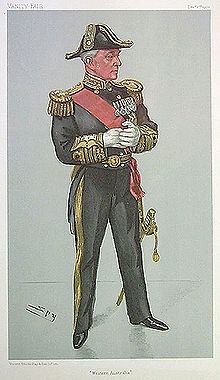Frederick Bedford
| Sir Frederick Bedford | |
|---|---|

|
|
| Born | 24 December 1838 |
| Died | 30 January 1913 (aged 74) |
| Allegiance |
|
| Service/branch |
|
| Years of service | 1852 – 1903 |
| Rank | Admiral |
| Commands held |
Cape of Good Hope Station North America and West Indies Station |
| Awards |
Knight Grand Cross of the Order of the Bath Knight Grand Cross of the Royal Victorian Order |
Admiral Sir Frederick George Denham Bedford, GCB, GCVO (24 December 1838 – 30 January 1913) was a senior Royal Navy officer and Governor of Western Australia from 24 March 1903 to 22 April 1909.
Bedford joined the Royal Navy at the age of 14, and later served in the Crimean War.
He was appointed Commander-in-Chief, Cape of Good Hope and West Coast of Africa Station in 1892: in 1894, Admiral Sir Frederick Bedford was involved in an action against Nana Olomu Chief of Benin. Brohomi was burnt down in 1894 by a combined force of the British Naval Brigade and the Niger Coast Protectorate Force under Sir Frederick Bedford, KCB and the Consul-General Ralph Moor, KCMG. It is believed over 500-600 slaves were freed during the operation. On 22 February 1895, a British naval force, under the command of Admiral Sir Frederick Bedford at the behest of the Royal Niger Company, granted a royal charter by Queen Victoria in 1886, laid siege on Brass, the chief city of the Ljo people of Nembe in Nigeria's Niger Delta.
He was appointed Junior Naval Lord in 1889 and Second Naval Lord in 1895.
In 1899 he was appointed commander-in-chief of the North America and West Indies Station, serving with the flagship HMS Crescent. The squadron under his command visited Jamaica in February 1900. He held the North America post until 15 July 1902, when he was succeeded by Vice-Admiral Sir Archibald Douglas, and left homebound with the Crescent.
...
Wikipedia
